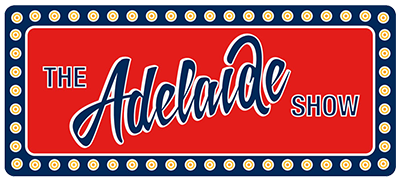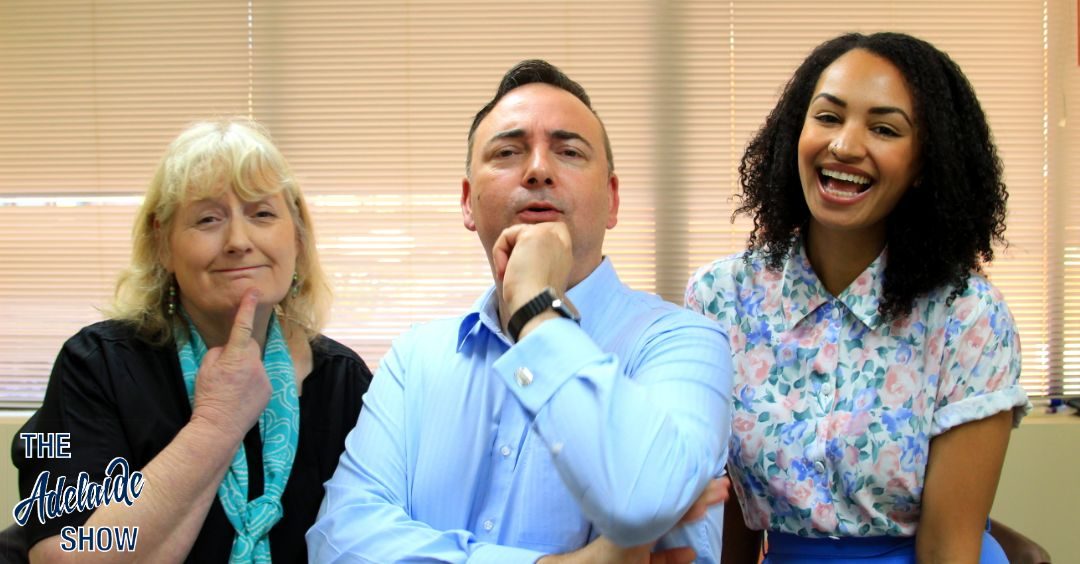In this week’s episode of The Adelaide Show, we go behind TV for kids with Amelia Moseley from Behind The News and Sandy Boyce who was a writer for Here’s Humphrey many years ago.
Also this week, the SA Drink Of The Week is from Robern Menz.
Our new sponsor, Adelaide Night And Day Family Therapy, continues tonight, with occupational therapist, Johanna de Kort, exploring senses, and when they are over sensitive.
And in the Musical Pilgrimage, we have a track from Emily Davis – one of the acts at the Port Rocks Fringe event.
Tickets on sale now for Steve’s 2019 Adelaide Fringe Show – 2 Cat’s On A Hot Fringe Roof. Please buy some, especially the dinner and show ticket because it enters you into a great, wine-loving draw.
And please consider becoming part of our podcast by joining our Inner Circle. It’s an email list. Join it and you might get an email on a Sunday or Monday seeking question ideas, guest ideas and requests for other bits of feedback about YOUR podcast, The Adelaide Show. Email us directly and we’ll add you to the list: [email protected]
If you enjoy the show, please leave us a 5-star review in iTunes or other podcast sites, or buy some great merch from our Red Bubble store – The Adelaide Show Shop. We’d greatly appreciate it.
And please talk about us and share our episodes on social media, it really helps build our community. Oh, and here’s our index of all episode in one concise page
Running Sheet: Behind TV for kids
| TIME | SEGMENT |
| 00:00:00 | Intro |
| 00:00:08 | SA Drink Of The Week |
|
Menz Dark Chocolate Coated Coffee Beans. We chose this as our “drink” instead of an alcoholic one because Behind The News has done quite a few stories about the dangers of alcohol, especially if you are under 25. |
|
| 00:05:46 | Mindful Moment with Adelaide Night and Day Family Therapy |
| In this week’s Mindful Moment, principal of Adelaide Night and Day Family Therapy, Johanna De Kort, explores senses, and when they are over sensitive. | |
| 00:11:51 | Amelia Moseley and Rev Sandy Boyce |
|
In the Sound of Music, Maria is trying to explain singing and musical scales to the children in her care and when she get blank stares from them she stops, thinks, and then turns the process into the now-famous song, Do Rei Mi. Was that a case of dumbing things down, or was it a case of a communicator taking responsibility for shaping a message into a format better suited to their audience? As I’ve been watching lots of kids TV in preparation for my Fringe show, 2 Cats On A Hot Fringe Roof, which I am performing with man who played Fat Cat on TV (Ralf Hadzic) while being directed by a man who was one of Humphrey B Bear’s offsiders (Glynn Nicholas), I’ve been noticing many different ways that programs talk to children. To ponder this some more, I have two perfect guests. Amelia Moseley, presenter of Behind The News. And Rev Sandy Boyce, a former teacher who was once a writer for Here’s Humphrey.
Sandy, I trawled the internet looking for your background and I didn’t find links between you and the jolly old fellow. Can you set up your background for us in kids’ TV? Amelia, you have one of the dream-come-true stories. You grew up watching Behind The News and now your its presenter. What are some of the stepping stones in your career so far? Sandy, when you were a teacher, did you show Behind The News to your classrooms? Sandy, do you think your teaching background helped form your communication skills for TV writing, counselling, preaching, etc? Tell us about the writing style for Here’s Humphrey? Glynn Nicholas explained to me that his famous character, Pate Biscuit, was based on him watching new presenters speak in patronising, sing songy ways to kids. You wrote a long letter to management once, didn’t you, Sandy? Tell us about the writing style for Behind The News? Is there a style guide for example, do you have to say PM or Prime Minister, etc? Take us through the delicate but important challenge of breaking down a story for BTN? Let’s take the Australia Day Date Debate. You If you had to find similarities between the two shows, what would they be? Amelia, what are the challenges in covering issues which divide people on political grounds? Things like Climate Change and Australia Day and Reconciliation? I have two samples I’d like to play from your podcast version. 1. Here’s the update from January 23 with coverage of the World Economic Forum. So we heard from David Attenborough and also Jacinda Ardern about being on the right side of history. What compass do you use for navigating climate change when scientists are so settled on the issue but tabloids and some noisy parts of society are not? 2. And here’s the update from January 28 with coverage of Australia Day. So we heard from people wanting to change the date and Scott Morrison saying keep it. There’s no commentary there telling us what to think? How do you navigate this one where people on either side will be thinking you are too soft on the opposition to their points of view? There is a mixture of “smiley” voice in BTN. How do you stop that from tipping into being patronising? Here are the references to the cyberbullying story: See tips for parents about supporting their children see www.kidshelpline.com.au/parents. Access survey findings at ‘The Prevention and Reduction of Cyberbullying of Young People’ www.yourtown.com.au/insights/research-and- AJ: What was your first BTN story and which one was your favourite? |
|
| 01:09:07 | Musical Pilgrimage |
|
In the musical pilgrimage, we have a track from Emily Davis.
We last featured Emily when she launched her album, You, Me and the Velvet Sea in episode 242 in April 2018, which happened to be the last time we interviewed by Fringe show partner, Ralf Hadzic.
|
|
Here’s this week’s preview video:
SFX: Throughout the podcast we use free sfx from freesfx.co.uk for the harp, the visa stamp, the silent movie music, the stylus, the radio signal sfx, the wine pouring and cork pulling sfx, and the swooshes around Siri.

